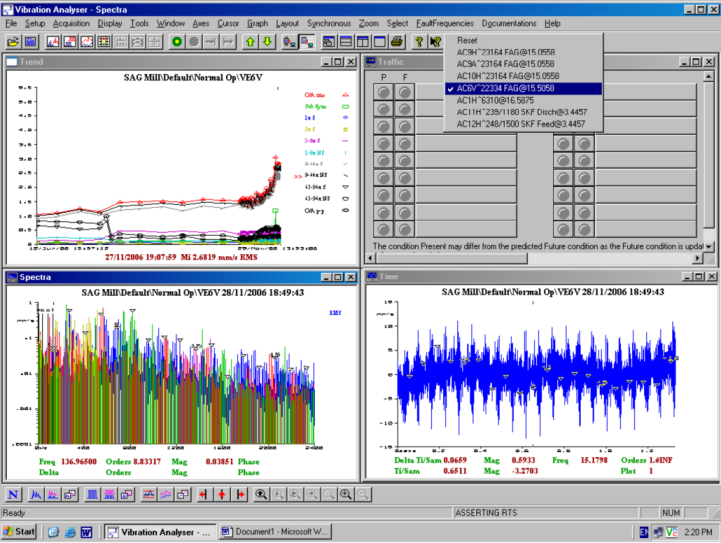
|
|
|
Fatigue cracks grow very fast once they go past critical size. Fatigue cracks in shafts at shoulders or under bearing inner rings, such as on large overhung fans are caused by high local stresses. The slow growth of sub critical cracks which over many years join with other sub critical cracks finally, after 5, 10 or 20 years produce a critical sized crack which grows quicly in the next million stress cycles, over a day or so.
Our Online system “ticks around” from sensor to sensor spending a moment at each, and with 60 sensors = 1 hr cycle time, may have missed this final failure, which happened over 10 minutes. Combination of the two devices gives long term trending and close to full failure capabilities. The machine was 15 years old.
Some bearing faults detected at low levels can trend flat for years & spall badly in several weeks.
Each trend has it’s own limits (not shown) with the bearing in alarm for over 1 year and now at shutdown level, but the gear is just entering alarm level at this stage because gears normally run at higher vibration levels than bearing faults. The gears are now meshing poorly because of the bearing fault. Bearing fault trend (9-64x non sync) represents all non sync spectral lines in that band. The spectrum below the trend graph highlights harmonics of each of the 3 shaft speeds (sync vibration) with a different color and the unhighlighted blue lines represent the non sync vibration which is due to bearing vibration. The analyst can overlay ball pass frequency markers, in this case a brg 6 inner race fault, to confirm the automated diagnosis of a bearing fault, based on knowledge of non sync vibration. 
The time domain of the spectrum can be highlighted by the analyst to show a waveform dominated by peaks at 0.0659 sec spacing corresponding to shaft speed of 15.5 Hz which is the intermediate shaft speed, which modulates the 136.96 Hz ball pass frequency each time the shaft turns and the damaged section enter the loaded zone. Explanation of fatigue cracks and rapid final failure There are many examples of hardened gears working for 25 years without significant surface wear, and then suddenly failing in a few hours or few days. By chance, I have been on site and recorded a 5 MW steam turbine generator epicyclic gearbox in very good condition, deteriorate over 3 days from tooth face fatigue, to the point of shutdown. Years earlier a similar 12 MW epicyclic gearbox (5000 rpm in/1500 rpm out) deteriorated over several hours, according to the night operators, to the point of shutdown. In both cases there were huge pieces of tooth missing from many of the gears. Some displayed the initial fatigue water marks, and others only with overload failure due to broken parts going through the mesh. Why do fatigue failures like this happen so suddenly after so long? The consensus is that over a vast number of cycles small sub surface slag inclusions and surface defects, much smaller than critical sized cracks, gradually grow due to stress variations. Over time and by chance they meet and form larger cracks, and at some point a critical sized crack is formed. From this moment on, the part, and therefore the machine has 1 million cycles of life left before it fails.
Why do cracks only create detectable vibration in the later stages failure?
So, only when a crack covers a high % of the cross section, can it effect deflection and therefore vibration, at which point the shaft or gear tooth is close to breaking off.
|